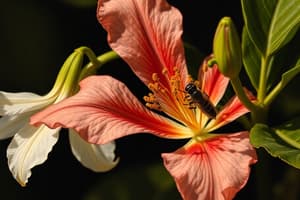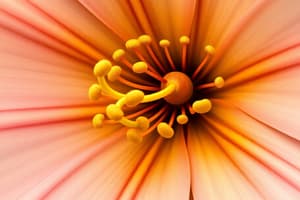Podcast
Questions and Answers
What is the primary function of the stamen in a flower?
What is the primary function of the stamen in a flower?
- To support the pistil
- To protect the ovule
- To attract pollinators
- To produce and release pollen (correct)
Which of the following accurately describes self-pollination?
Which of the following accurately describes self-pollination?
- Pollination without any agents
- Pollen transfer between different flowers
- Only insects facilitate this process
- Pollen transfer between the same flower's stamen and pistil (correct)
Which part of the flower typically displays bright colors and plays a role in pollination?
Which part of the flower typically displays bright colors and plays a role in pollination?
- Petals (correct)
- Stigma
- Ovary
- Sepals
What does the process of double fertilization in angiosperms result in?
What does the process of double fertilization in angiosperms result in?
What is the role of pollinating agents in the process of pollination?
What is the role of pollinating agents in the process of pollination?
What occurs after fertilization in flowering plants?
What occurs after fertilization in flowering plants?
Which statement about seed dispersal is true?
Which statement about seed dispersal is true?
What condition must a dormant seed meet to start germination?
What condition must a dormant seed meet to start germination?
What is the significance of the ovary in flowering plants?
What is the significance of the ovary in flowering plants?
What is the primary difference between insect-pollinated flowers and wind-pollinated flowers?
What is the primary difference between insect-pollinated flowers and wind-pollinated flowers?
Flashcards are hidden until you start studying
Study Notes
Structure of a Typical Flower
- Cooperative learning activity involves collecting complete and incomplete flowers for examination.
- Students should identify floral parts, focusing on stamen (male) and pistil (female).
- Brightly colored floral parts attract pollinators, influencing flower design and pollination methods.
Pollination
- Defined as the transfer of pollen from anther (stamen) to stigma (pistil).
- Can occur as self-pollination (within one flower) or cross-pollination (between different flowers).
- Requires agents such as insects or wind for effective pollen transfer.
- Flower structure influences the type of pollinator it attracts.
Pollen Tube Formation
- Pollen grains form tubes upon reaching the stigma, which grow towards the ovule.
- This process prepares for fertilization by allowing male gametes to reach female gametes.
Fertilization
- Occurs when the male gamete unites with the female gamete inside the ovule.
- Results in the formation of a zygote, which develops into a seed embryo.
- Angiosperms (flowering plants) exhibit double fertilization, creating both a zygote and endosperm (nutrient storage).
Seed and Fruit Formation
- Post-fertilization, the ovule develops into a seed while the ovary matures into a fruit.
- The seed represents a matured ovule; the fruit represents a matured ovary.
Seed Dispersal
- Mechanism for scattering seeds away from the parent plant to reduce competition.
- Dispersal involves various agents, including animals and wind.
Seed Dormancy and Germination
- Seeds may enter a dormancy phase, remaining inactive until favorable conditions arise.
- Germination is triggered by sufficient water and nutrients, leading to the growth of the seedling (young plant).
- Seed germination marks the transition from dormancy to active growth.
Studying That Suits You
Use AI to generate personalized quizzes and flashcards to suit your learning preferences.




